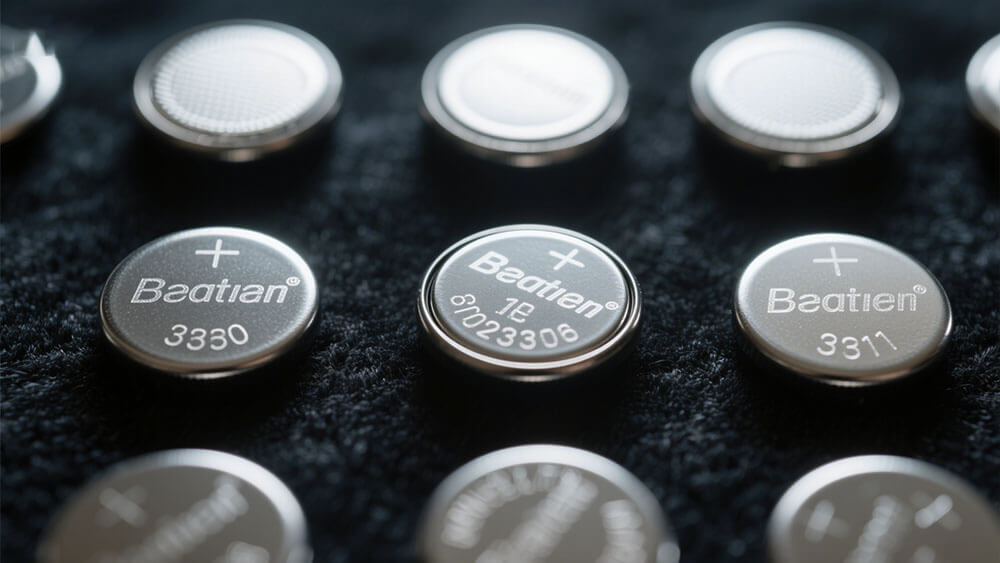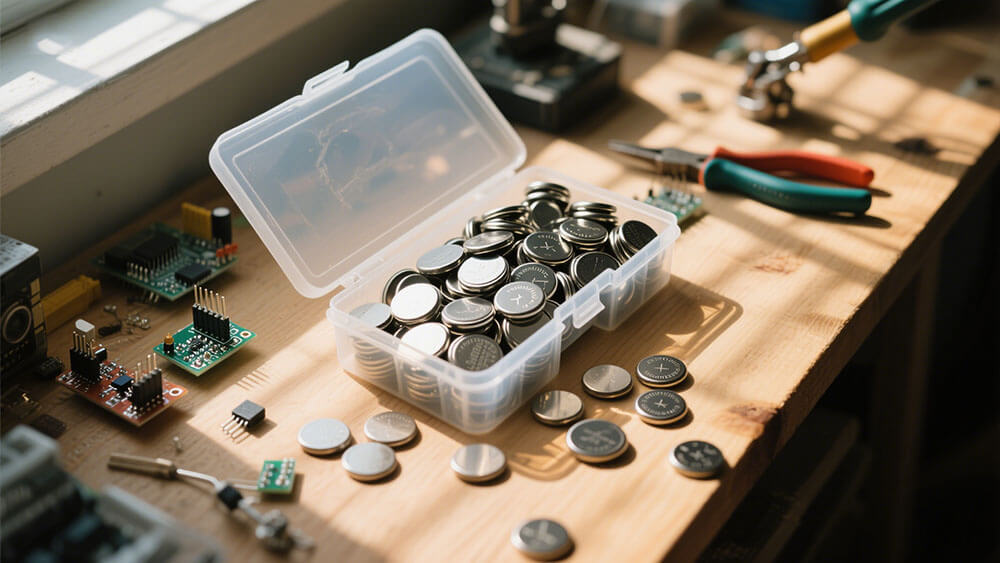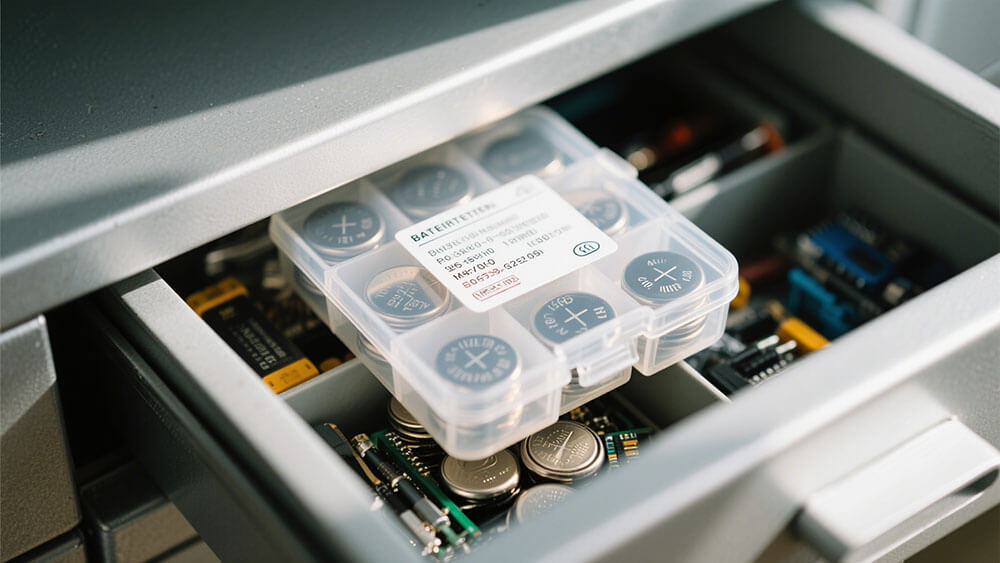
Button batteries are small, disc-shaped power sources essential for compact electronic devices. Their compact size and efficiency make them ideal for wearables, medical devices, and automotive applications. With the button battery market projected to grow at a 6.1% CAGR, understanding button battery sizes and types is critical for selecting reliable and efficient power solutions in industrial and commercial settings.
Key Takeaways
Button batteries have types like lithium coin, alkaline, silver oxide, and zinc air. Each type works for specific uses.
Check your device’s size and voltage needs before buying batteries. This ensures they fit and work well.
Handle and store button batteries carefully to avoid accidents, especially with kids. Recycling them helps protect the environment.
Part 1: Types of Button Batteries

1.1 Lithium Coin Batteries
Lithium coin batteries are among the most widely used button batteries due to their high energy density and long shelf life. These batteries are ideal for devices requiring reliable, long-term power, such as medical devices, key fobs, and small IoT devices. Their compact design and lightweight nature make them a preferred choice for applications where space and weight are critical factors.
Lithium coin batteries operate at a nominal voltage of 3V, which is higher than most other button battery types. This higher voltage ensures consistent performance in devices with moderate to high energy demands. Additionally, these batteries can function effectively across a wide temperature range, making them suitable for both consumer electronics and industrial applications. Their ability to retain up to 90% of their charge after ten years of storage further highlights their reliability.
Tip: When selecting lithium coin batteries, always verify the compatibility with your device’s voltage and size requirements to ensure optimal performance.
1.2 Alkaline Button Batteries
Alkaline button batteries are known for their affordability and widespread availability. These batteries are commonly used in devices with low to moderate power requirements, such as calculators, remote controls, and small toys. While they may not offer the same energy density as lithium coin batteries, their cost-effectiveness makes them a popular choice for everyday applications.
The following table highlights key metrics that demonstrate the reliability and cost-efficiency of alkaline button batteries:
Metric | Value |
|---|---|
Global production in 2024 | |
Portable electronic devices sold | 1.5 billion |
Average household consumption | 50 alkaline batteries/year |
Industrial usage in 2024 | 3 billion alkaline batteries |
Asia-Pacific consumption | 6 billion alkaline batteries |
Energy capacity improvement | Up to 20% more energy |
Global recycling in 2024 | 500 million alkaline batteries |
Consumer preference | 70% prefer for affordability |
Despite their lower energy capacity compared to lithium coin batteries, alkaline button batteries remain a practical choice for applications where cost is a primary consideration.
1.3 Silver Oxide Button Batteries
Silver oxide button batteries are prized for their stable output voltage and high energy-to-weight ratio. These characteristics make them ideal for precision instruments like watches, hearing aids, and medical devices. Their ability to deliver consistent power over extended periods ensures the reliability of devices that require precise and uninterrupted operation.
Silver oxide batteries are preferred for their stable output voltage.
They have a high energy-to-weight ratio, making them suitable for small, portable devices.
The growing demand for long-lasting and efficient power sources is driving their market growth.
Silver oxide button batteries also exhibit a longer lifespan compared to alkaline button batteries, making them a cost-effective solution for applications where battery replacement is inconvenient or costly.
1.4 Zinc Air Button Batteries
Zinc air button batteries are unique in their operation, as they rely on oxygen from the air to generate power. This design allows them to achieve a high energy density, making them particularly suitable for hearing aids and other medical devices. Their lightweight construction and ability to deliver consistent power output further enhance their appeal for specialized applications.
A study on zinc air batteries revealed that introducing surfactants like sodium dodecyl sulfate (SDS) and Pluronic F-127 can significantly enhance their discharge capacity and energy density. Specifically, a 30% increase in specific discharge capacity was observed with 100 ppm P127, and a 24% increase with 0.2 mM SDS.
Zinc air batteries are also environmentally friendly, as they contain fewer toxic materials compared to other battery types. However, their reliance on air exposure means they have a shorter shelf life once activated, so proper storage is essential.
Part 2: Button Battery Sizes and Naming Conventions

2.1 How Button Battery Sizes Are Measured
Button battery sizes are determined by their physical dimensions, specifically their diameter and height. Manufacturers use millimeters as the standard unit of measurement, ensuring consistency across global markets. For example, a battery labeled “CR2032” has a diameter of 20mm and a height of 3.2mm. This precise sizing allows you to select batteries that fit seamlessly into compact devices like medical instruments or consumer electronics.
The size of a button battery directly impacts its energy capacity and compatibility. Larger batteries typically offer higher energy storage, making them suitable for devices with extended power requirements. Conversely, smaller batteries are ideal for applications where space constraints are critical, such as hearing aids or wearable technology.
Note: Always verify the size specifications of your device before purchasing button batteries. Incorrect sizing can lead to performance issues or damage to the device.
2.2 Common Naming Conventions for Button Batteries
Button battery naming conventions follow standardized codes that provide essential information about the battery’s chemistry, size, and voltage. Understanding these codes helps you identify the right battery for your application.
Key Naming Elements:
Prefix: Indicates the battery’s chemical composition. For instance:
“CR” represents lithium coin cell batteries.
“LR” denotes alkaline button batteries.
“SR” refers to silver oxide batteries.
“PR” signifies zinc air batteries.
Numeric Code: Specifies the battery’s dimensions. The first two digits represent the diameter, while the last two indicate the height. For example, “CR2032” means a lithium coin cell battery with a 20mm diameter and 3.2mm height.
Voltage: Some naming conventions include the nominal voltage, especially for industrial applications.
Why Naming Matters:
Standardized naming conventions simplify the selection process, ensuring compatibility and reliability. For instance, lithium coin cell batteries like CR2032 are widely used in IoT devices due to their high energy density and compact size.
2.3 Examples of Popular Button Battery Models
Several button battery models have gained popularity due to their versatility and performance. These models cater to diverse applications, ranging from consumer electronics to industrial systems.
Widely Used Models:
CR2032: Known for its high energy density and long shelf life, this lithium coin cell battery powers devices like glucose monitors, key fobs, and IoT sensors.
LR44: An alkaline button battery commonly found in calculators, toys, and remote controls. Its affordability makes it a practical choice for everyday use.
SR626SW: A silver oxide battery favored for precision devices like watches and medical instruments. Its stable voltage ensures consistent performance.
PR41: A zinc air battery designed for hearing aids. Its lightweight construction and high energy density make it ideal for medical applications.
Statistical Trends Supporting Popularity:
Expanding usage in consumer electronics, including devices like hearing aids and remote controls.
Growth of the medical device industry, with increased demand for stable power sources in devices such as glucose monitors and pacemakers.
Increasing adoption of wearable technology, driven by consumer preferences for portable electronic devices.
Demand for environmentally friendly battery technologies as sustainability becomes a priority for consumers and manufacturers.
Rise of IoT devices, necessitating efficient power sources for various applications.
Tip: If you require custom battery solutions tailored to your industrial needs, explore Large Power’s custom battery solutions.
Part 3: Applications of Button Batteries

3.1 Use in Consumer Electronics
Button batteries play a pivotal role in powering small electronic devices, especially in the consumer electronics sector. Their compact size and reliable performance make them ideal for devices like remote controls, digital cameras, and wearable technology. For example, lithium coin batteries, such as the CR2032, are widely used in smartwatches and fitness trackers due to their high energy density and long shelf life. These batteries ensure uninterrupted operation, even in devices with moderate energy demands.
The growing popularity of wearable technology and IoT devices has further increased the demand for button batteries. Their ability to deliver consistent power in compact designs aligns perfectly with the needs of modern consumer electronics. If you’re exploring battery solutions for consumer electronics, consider custom battery solutions tailored to your specific requirements.
3.2 Role in Medical Devices
Medical devices rely heavily on button batteries for their precision and reliability. Devices like hearing aids, glucose monitors, and pacemakers require stable power sources to ensure accurate operation. Silver oxide and zinc air batteries are commonly used in these applications due to their consistent voltage output and lightweight design.
However, safety concerns surrounding button batteries in medical devices have emerged. Ingestion incidents, particularly involving lithium batteries, have led to severe injuries and fatalities. The following table highlights key safety records related to button battery ingestion:
Evidence Type | Details |
|---|---|
Ingestion Hazard Statistics | 69 deaths reported due to button cell or coin battery ingestion from 1977 to June 2022. |
Battery Chemistry Involvement | 44 deaths involved lithium batteries, 2 involved manganese dioxide, and 1 involved alkaline. |
Common Sources of Batteries | Batteries were found in items like remote controls, toys, watches, and loose batteries. |
Symptoms of Ingestion | Symptoms often misdiagnosed as infections; severe cases led to vomiting blood or death. |
Cause of Deaths | 50 deaths due to battery burning through the esophagus, creating holes in adjoining tissues. |
To mitigate risks, manufacturers have implemented safety measures, including child-resistant packaging and warning labels. For more insights into medical battery applications, visit Medical Battery Solutions.
3.3 Industrial and IoT Applications
Industrial systems and IoT devices demand compact, efficient power solutions, making button batteries indispensable. These batteries power sensors, trackers, and other devices critical to infrastructure and industrial operations. Lithium coin batteries, with their high energy density and long lifespan, are particularly suited for IoT applications.
Market analysis reveals significant growth in the button battery sector, driven by IoT adoption and technological advancements. The table below outlines key trends:
Evidence Type | Description |
|---|---|
Market Growth | The button cell market is experiencing significant growth driven by the demand for compact devices. |
IoT Adoption | The rise of IoT devices is increasing the need for reliable power solutions, which button cells provide. |
Technological Advancements | Innovations in battery technology are enhancing the performance and sustainability of button cells. |
Industrial applications often require batteries that can withstand harsh conditions while delivering consistent performance. Button batteries meet these demands, ensuring reliability in critical systems. Explore Industrial Battery Solutions for tailored options.
Part 4: Safety Considerations for Button Batteries

4.1 Proper Handling and Storage Guidelines
Proper handling and storage of button cell batteries are essential to prevent accidents and ensure their longevity. You should always store these batteries in a secure, childproof container, keeping them out of reach of children. Loose batteries left unattended pose significant risks, especially to young children who may mistake them for candy.
Approximately 3,500 people swallow button batteries annually, with half of these cases involving children aged six or younger.
Since 2002, 44 children have died from swallowing button batteries.
To minimize risks, avoid leaving batteries in easily accessible places like countertops or drawers. Always follow local regulations when disposing of used batteries to prevent environmental contamination.
4.2 Risks of Ingestion and Preventive Measures
Button battery ingestion is a serious safety concern, particularly for children. These small batteries can cause severe injuries if swallowed, including burns to the esophagus and damage to internal organs.
Statistic | Value |
|---|---|
Percentage of battery-related ED visits due to ingestions | 90% |
Total battery-related emergency room visits (2010-2019) | 70,000 |
Percentage of visits involving button batteries | 85% |
To prevent ingestion, manufacturers have introduced child-resistant packaging. As a parent or caregiver, you should inspect toys and devices to ensure battery compartments are secure. Educating children about the dangers of button batteries can also reduce the likelihood of accidents.
4.3 Disposal and Recycling Best Practices
Improper disposal of button cell batteries can harm the environment. Heavy metals in these batteries may contaminate groundwater and soil, while lithium batteries can ignite fires in landfills. Recycling batteries is a safer and more sustainable option. It reduces the need for mining critical minerals like lithium, cobalt, and graphite.
To dispose of batteries responsibly:
Use designated recycling facilities or drop-off points.
Avoid throwing batteries in regular trash bins.
Follow local guidelines for hazardous waste disposal.
By adopting these practices, you contribute to environmental sustainability. Learn more about sustainable battery solutions at Large Power’s sustainability page.
Understanding button battery sizes and types is essential for ensuring compatibility and efficiency in industrial applications. Selecting the right battery impacts device performance and longevity. Lithium coin batteries have become indispensable in modern electronics and IoT devices due to their high energy density and extended lifespan.
📈 Key Trends Driving Lithium Coin Battery Adoption:
The industrial IoT market is projected to reach $200 billion by 2026, increasing demand for robust battery solutions.
Lithium-ion batteries dominate the IoT market due to their superior energy density and cycle life.
By 2025, IoT-connected devices will exceed 41.6 billion, requiring efficient power sources.
Explore custom battery solutions from Large Power to meet your unique industrial needs.
FAQ
1. What are the differences between button battery types?
Button batteries differ in chemistry, voltage, and lifespan. Lithium coin batteries last longer, while hearing aid batteries like zinc air offer high energy density for medical devices.
2. How do you choose the right hearing aid batteries?
Select hearing aid batteries based on size, chemistry, and device compatibility. Zinc air batteries are ideal for hearing aids due to their lightweight design and consistent power output.
3. Can button batteries be recycled?
Yes, button batteries can be recycled at designated facilities. Recycling reduces environmental harm and conserves resources like lithium and zinc used in hearing aid batteries.




